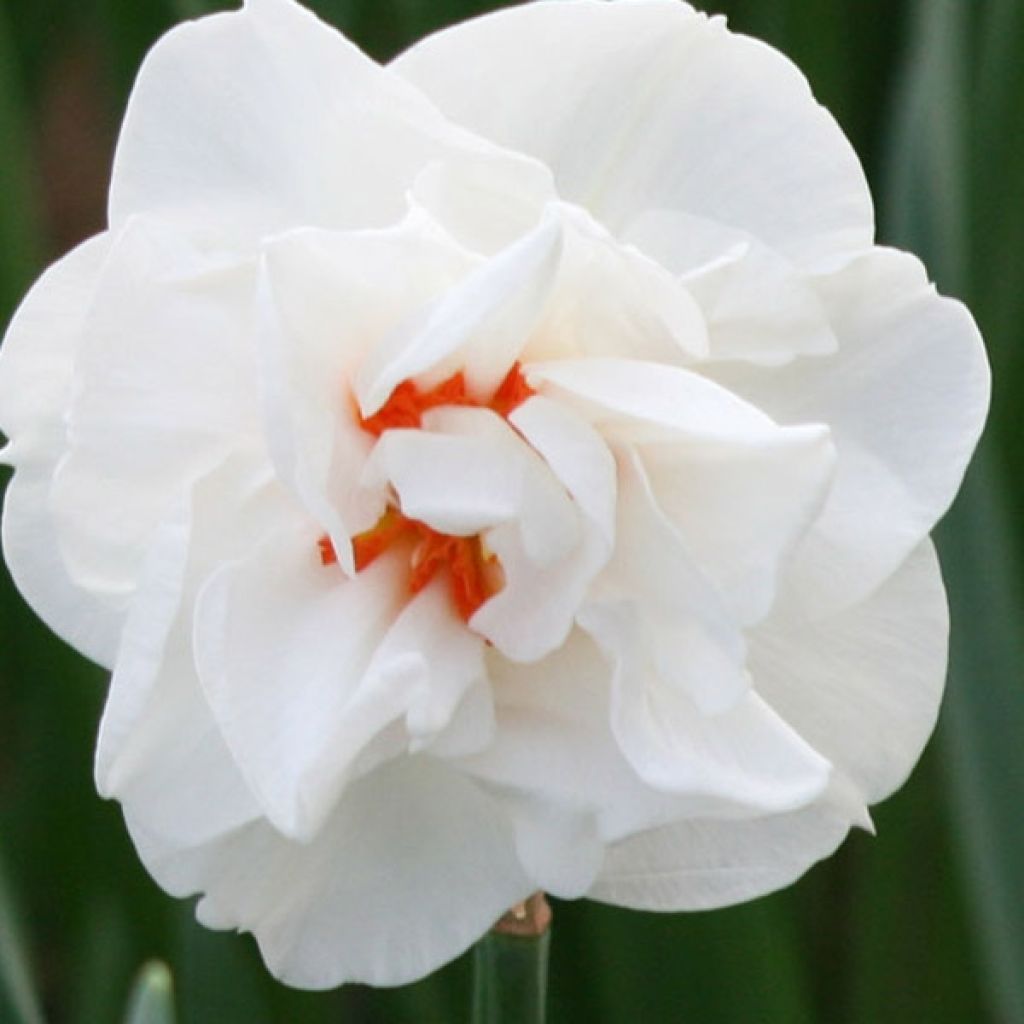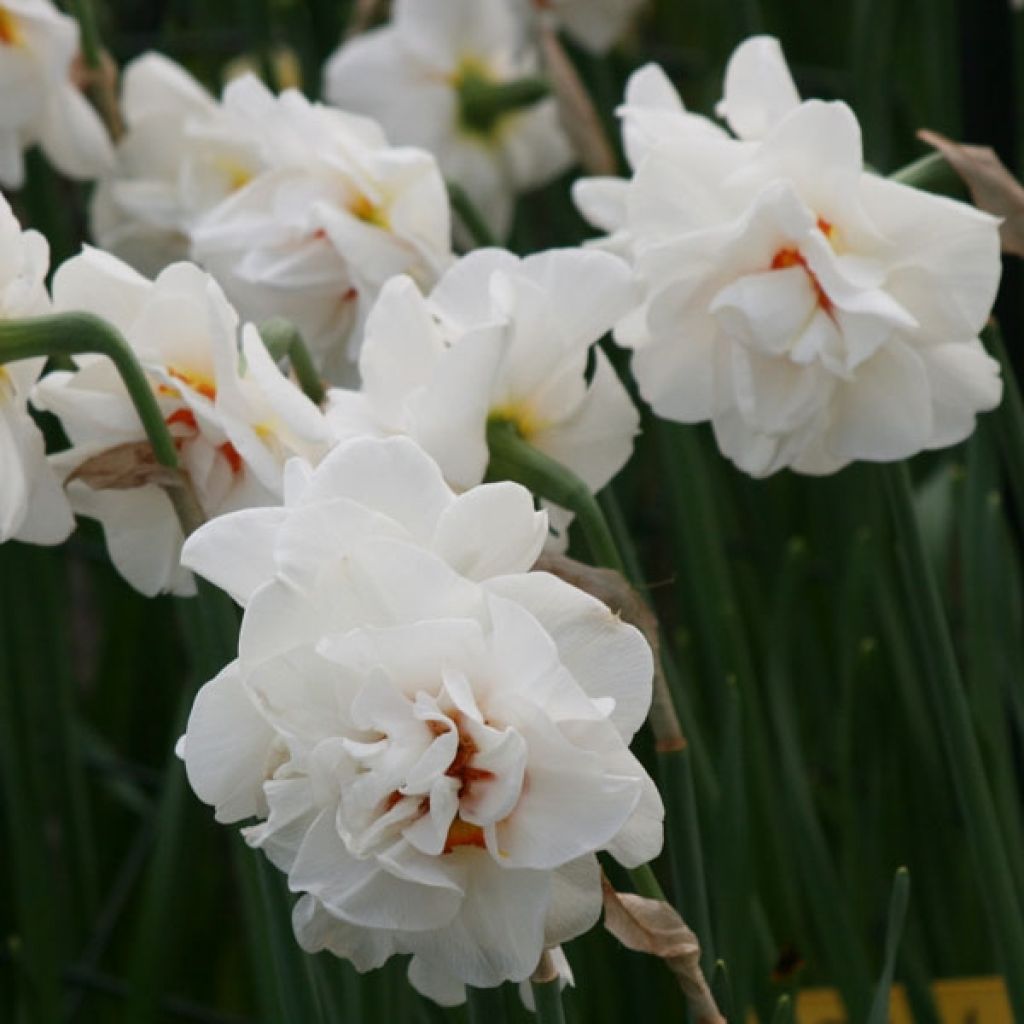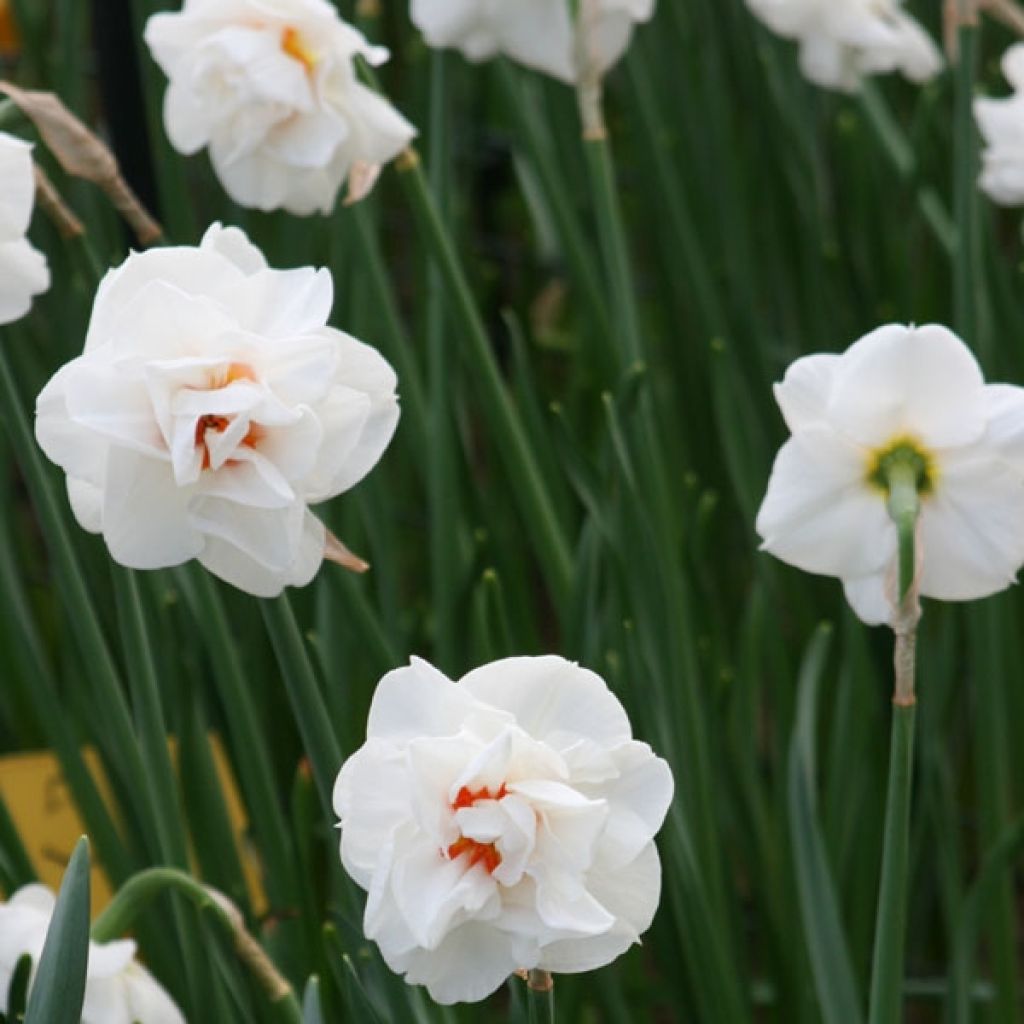

Narcissus Acropolis


Narcissus Acropolis


Narcissus Acropolis
Narcissus Acropolis
Narcissus Acropolis
Daffodil, Narcissus, Jonquil
This plant carries a 6 months recovery warranty
More information
We guarantee the quality of our plants for a full growing cycle, and will replace at our expense any plant that fails to recover under normal climatic and planting conditions.
From €5.90 for pickup delivery and €6.90 for home delivery
Express home delivery from €8.90.


Does this plant fit my garden?
Set up your Plantfit profile →
Description
'Acropolis' Double-flowered Narcissus unfolds an exceptionally large, solitary flower at the end of each of its tall stems, with a subtly spicy fragrance. Its corolla is fully double, pure white warmed by a touch of bright orange at the heart. It generally flowers in May, earlier or later depending on the climate. It is a remarkable cut flower, which also has a beautiful effect in a border, flowerbed, mass planting, or large container. This old variety has been awarded several times for its ornamental qualities and performance in the garden. Pair it with grape hyacinths or scarlet Triumph tulips!
The 'Acropolis' Double-flowered Narcissus belongs to the lily family (Amaryllidaceae), more precisely to division 4 of the large family of daffodils, which includes 12 divisions. The genus Narcissus includes around 50 species found mainly in the western Mediterranean, but also in Africa and Asia. The 'Acropolis' narcissus, introduced in 1955 in Ireland, is a cross between the Falaise and Limerick varieties. This excellent, historic creation, has given rise to 5 more recent varieties. 'Acropolis' sends up a 55 cm (22in) tall flowering stem. It is a large plant which flowers in May, with a large yellow-green floral bud that opens into magnificent double flowers, 11 cm (4in) wide. The very double corolla is pure white to pale ivory and pleasantly fragrant. Double-flowered daffodils have an extra crown of petals and a long flowering period. The flowers have numerous petal-like tepals. The stamens are transformed into petals and inserted into a cup-shaped paracorolla that looks crumpled and is bright orange in the Acropolis variety. The deciduous, linear, foliage disappears in summer.
There are so many daffodil varieties that you can enjoy them for three months in spring without ever getting tired. They can all naturalise easily, come in endless shades of yellow and white and often emit sweet fragrances. So many reasons to grow them in large groups on the lawn or in a border (at least 20 bulbs) for a mass effect. Pair 'Acropolis' in wild or romantic flowerbeds, with scilla and hyacinths, plant it with double Angelique or single, bright red Red Impression tulips, or forget-me-nots, grape hyacinths, daisies, chamomiles, liverworts. A bunch of 'Acropolis' daffodils in a vase will look sensational. This narcissus is perfect for containers.
For bouquets: we advise you not to mix daffodils with other flowers, especially tulips, as the stems of daffodils contain a substance that causes other flowers to wither quickly. This adverse effect on other flower types can be mitigated by dipping the ends of the daffodil stems in hot water for 1 to 2 minutes.
Narcissus are also called daffodils and these belong to division 7 of the group. Native to southern Europe and North Africa, they have flowers grouped in pairs or more. Botanical species have retained the charms of wild plants and thrive in rock gardens: N.bulbocodium, N. canaliculatus, N.juncifolius, N.pseudonarcissus, and the simple wood jonquil are among the prettiest.
Report an error about the product description
Plant habit
Flowering
Foliage
Botanical data
Narcissus
Acropolis
Amaryllidaceae
Daffodil, Narcissus, Jonquil
Cultivar or hybrid
Planting and care
Daffodils bloom from March to May and come back every year. They are easy to grow and will thrive in the shade of woodland as well as in a sunny flower bed. Plant them 10 cm (4in) deep and 10 cm (4in) apart, in sets of at least 5 bulbs, in patches of uniform or mixed colours. To plant them in a lawn: lift a patch of turf, dig and loosen the soil to a depth of at least 20 cm (8in) (the height of a spade), place your bulbs, cover them with soil and replace the turf. Choose a spot where you won't mow, as you must let daffodil leaves wither before cutting them. It is now that the bulb rebuilds itself and prepares the flowers for the following year. However, cut the flowers as soon as they have faded to prevent seed formation which would unnecessarily exhaust the bulb.
Planting period
Intended location
Care
-
, onOrder confirmed
Reply from on Promesse de fleurs
Haven't found what you were looking for?
Hardiness is the lowest winter temperature a plant can endure without suffering serious damage or even dying. However, hardiness is affected by location (a sheltered area, such as a patio), protection (winter cover) and soil type (hardiness is improved by well-drained soil).

Photo Sharing Terms & Conditions
In order to encourage gardeners to interact and share their experiences, Promesse de fleurs offers various media enabling content to be uploaded onto its Site - in particular via the ‘Photo sharing’ module.
The User agrees to refrain from:
- Posting any content that is illegal, prejudicial, insulting, racist, inciteful to hatred, revisionist, contrary to public decency, that infringes on privacy or on the privacy rights of third parties, in particular the publicity rights of persons and goods, intellectual property rights, or the right to privacy.
- Submitting content on behalf of a third party;
- Impersonate the identity of a third party and/or publish any personal information about a third party;
In general, the User undertakes to refrain from any unethical behaviour.
All Content (in particular text, comments, files, images, photos, videos, creative works, etc.), which may be subject to property or intellectual property rights, image or other private rights, shall remain the property of the User, subject to the limited rights granted by the terms of the licence granted by Promesse de fleurs as stated below. Users are at liberty to publish or not to publish such Content on the Site, notably via the ‘Photo Sharing’ facility, and accept that this Content shall be made public and freely accessible, notably on the Internet.
Users further acknowledge, undertake to have ,and guarantee that they hold all necessary rights and permissions to publish such material on the Site, in particular with regard to the legislation in force pertaining to any privacy, property, intellectual property, image, or contractual rights, or rights of any other nature. By publishing such Content on the Site, Users acknowledge accepting full liability as publishers of the Content within the meaning of the law, and grant Promesse de fleurs, free of charge, an inclusive, worldwide licence for the said Content for the entire duration of its publication, including all reproduction, representation, up/downloading, displaying, performing, transmission, and storage rights.
Users also grant permission for their name to be linked to the Content and accept that this link may not always be made available.
By engaging in posting material, Users consent to their Content becoming automatically accessible on the Internet, in particular on other sites and/or blogs and/or web pages of the Promesse de fleurs site, including in particular social pages and the Promesse de fleurs catalogue.
Users may secure the removal of entrusted content free of charge by issuing a simple request via our contact form.
The flowering period indicated on our website applies to countries and regions located in USDA zone 8 (France, the United Kingdom, Ireland, the Netherlands, etc.)
It will vary according to where you live:
- In zones 9 to 10 (Italy, Spain, Greece, etc.), flowering will occur about 2 to 4 weeks earlier.
- In zones 6 to 7 (Germany, Poland, Slovenia, and lower mountainous regions), flowering will be delayed by 2 to 3 weeks.
- In zone 5 (Central Europe, Scandinavia), blooming will be delayed by 3 to 5 weeks.
In temperate climates, pruning of spring-flowering shrubs (forsythia, spireas, etc.) should be done just after flowering.
Pruning of summer-flowering shrubs (Indian Lilac, Perovskia, etc.) can be done in winter or spring.
In cold regions as well as with frost-sensitive plants, avoid pruning too early when severe frosts may still occur.
The planting period indicated on our website applies to countries and regions located in USDA zone 8 (France, United Kingdom, Ireland, Netherlands).
It will vary according to where you live:
- In Mediterranean zones (Marseille, Madrid, Milan, etc.), autumn and winter are the best planting periods.
- In continental zones (Strasbourg, Munich, Vienna, etc.), delay planting by 2 to 3 weeks in spring and bring it forward by 2 to 4 weeks in autumn.
- In mountainous regions (the Alps, Pyrenees, Carpathians, etc.), it is best to plant in late spring (May-June) or late summer (August-September).
The harvesting period indicated on our website applies to countries and regions in USDA zone 8 (France, England, Ireland, the Netherlands).
In colder areas (Scandinavia, Poland, Austria...) fruit and vegetable harvests are likely to be delayed by 3-4 weeks.
In warmer areas (Italy, Spain, Greece, etc.), harvesting will probably take place earlier, depending on weather conditions.
The sowing periods indicated on our website apply to countries and regions within USDA Zone 8 (France, UK, Ireland, Netherlands).
In colder areas (Scandinavia, Poland, Austria...), delay any outdoor sowing by 3-4 weeks, or sow under glass.
In warmer climes (Italy, Spain, Greece, etc.), bring outdoor sowing forward by a few weeks.



































